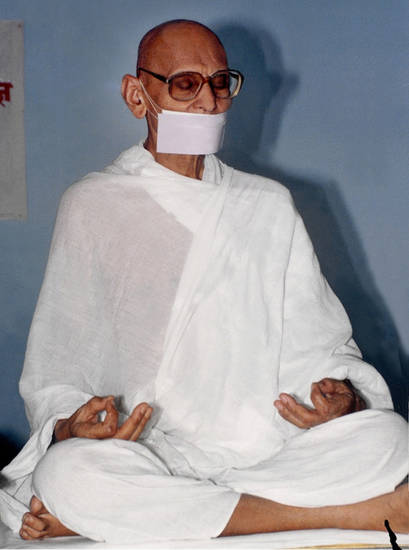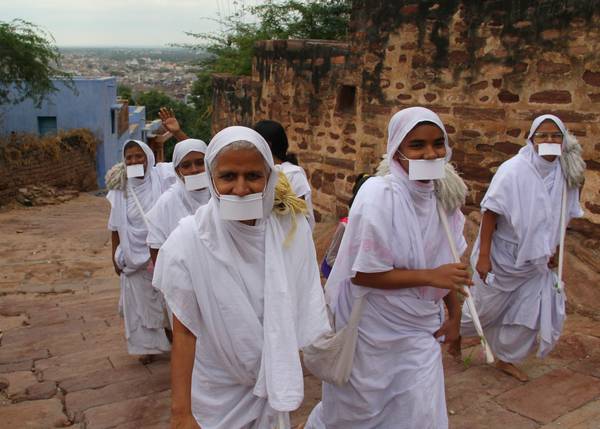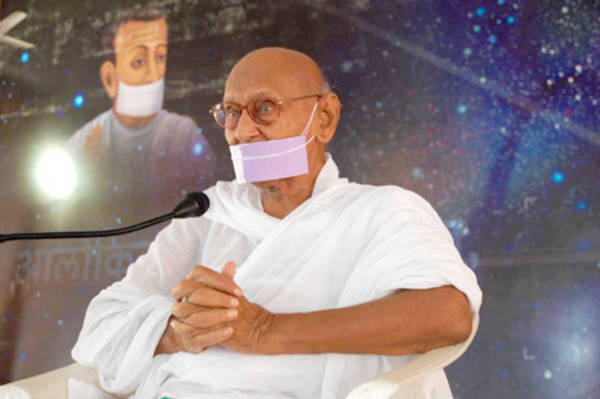Article: Śvetāmbara Terāpanthin
The Terāpanthins are the monastic members and lay followers of the Terāpantha, a Śvetāmbara Jain order. Associated with Rajasthan since its foundation in the 18th century, the Terāpantha sect is expanding rapidly among Jains inside and outside India.
The Hindi term terāpantha or terahpantha means either ‘your path’ or ‘path of 13’. Terāpanthins follow 13 main elements of Jain thought. They do not worship images but practise asceticism and ‘insight meditation’. The major characteristics of the Śvetāmbara Terāpanthin sect are the concentration of power in a single ācārya and a new type of ascetic – the male samaṇas and the female samaṇis. All Jains believe that they should avoid actions that produce bad karma because it blocks liberation of the soul. Terāpanthins also believe that believers seeking liberation should avoid actions that produce good karma too, because both good and bad karma ultimately obstruct salvation.
There is also a different group known as Terāpantha among the Digambara laity.
Origins
The Terāpantha was founded by Muni Bhikhan (1726–1803), who was later known as Ācārya Bhikṣu. He was born in the village of Kantaliya near Jodhpur in Rajasthan. His parents belonged to the Osvāl caste, which has always supplied a large number of recruits to the Terāpantha. Many Osvāls follow the tradition of worshipping idols while many others follow the Sthānaka-vāsins as well.
After his wife’s death, Bhikhan entered the monastic order of the Sthānaka-vāsin, who are against worshipping images. But Bhikhan left and formed a new group with 12 other men. Ācārya Bhikṣu’s opponents scorned it as the ‘path of the 13 – terah-panth – but he understood it as meaning ‘your group’ – terā panth. He also interpreted the number 13 as referring to the following principal points of Jain doctrine:
- the ‘five major vows’ – mahā-vratas
- the ‘three restraints’ – gupti
- the ‘five precautions’ – samiti.
Monastic organisation
The Terāpantha monastic order has an important feature which distinguishes it from other Jain monastic orders. Ācārya Bhikṣu set out the maryādā, a code of practice for ascetics, in which there is a single ācārya, who is a teacher-cum-group leader. He holds all the power in the sect and is chosen by his predecessor. Ācārya Bhikṣu established this rule to prevent schisms and the development of loose discipline.
The ācārya is a central autocratic leader who:
- initiates all monks and nuns
- chooses his successor, who is given the title of Yuvācārya
- decides the number and size of the different groups of mendicants by selecting their members during the annual plenary assembly called Maryādā Mahotsava.
The ācārya takes all important decisions even though he is constantly moving around the country.
|
Name |
Dates |
|
|---|---|---|
|
Birth |
Ācāryaship |
|
|
Ācārya Bhikṣu |
1726 |
1760–1803 |
|
Ācārya Bharimal |
1747 |
1803–1821 |
|
Ācārya Jītmal |
1803 |
1821–1881 |
|
Ācārya Maghrāj |
1810 |
1881–1892 |
|
Ācārya Manaklāl |
1855 |
1892–1897 |
|
Ācārya Dalchand |
1852 |
1897–1909 |
|
Ācārya Kālugaṇi |
1877 |
1909–1936 |
|
Ācārya Tulsi |
1914 |
1936–1997 |
|
Ācārya Mahāprajña |
1921 |
1997–2010 |
|
Ācārya Mahāśramaṇa |
1962 |
2010 to present |
There is also a chief nun – sādhvī-pramukhā – who is the head of the female ascetics but she is subordinate to the ācārya.
Since it was founded, the Terāpantha monastic order has grown more or less regularly, peaking during the 20th century.
|
Date |
Total ascetics |
||
|---|---|---|---|
|
18th century – Ācārya Bhikṣu |
21 |
27 |
48 |
|
1955 |
180 |
480 |
660 |
|
1975 |
151 |
506 |
657 |
|
1981 |
164 |
531 |
695 |
|
1999 |
145 |
543 |
688 |
Samaṇas and samaṇis
Until 1980 mendicants in the Terāpantha order were either monks – sādhus – or nuns – sādhvīs – as in the other Jain monastic orders. In the modernisation process characteristic of his reign, Ācārya Tulsi created a new intermediate category. The males in this new ascetic class are called samaṇas and the females samaṇis. There are many more samaṇis than samaṇas.
Whereas traditional Jain mendicants are only allowed to go on foot, samaṇas and samaṇis may use transport. This is a very important innovation because it allows them to travel abroad on missionary tours. For many Jains living outside India samaṇas and samaṇis are the only Jain mendicants with whom they can have direct contact.
|
Year |
Samaṇas |
|
|---|---|---|
|
1992 |
4 |
51 |
|
1996 |
4 |
81 |
|
1999 |
4 |
80 |
The Terāpanthin monks and nuns wear the usual non-stitched white monastic robes common among Śvetāmbara mendicants. They also permanently cover their mouth with a rectangular mouth-cloth – mukhavastrikā or muṃhapattī.
The samaṇas and samaṇis, however, wear a different type of stitched outfit and use their mouth-cloths only when speaking. These are not attached to their mouths.
Scriptures and philosophy

Discussing the scriptures
Image by Amitjain80 © CC BY-SA 3.0
The Terāpanthins recognise the authority of 32 of the Śvetāmbara canonical scriptures. Influenced by the most recent ācāryas, Tulsi and Mahāprajña, Terāpanthin mendicants have published numerous critical editions, indexes, dictionaries and analyses of these scriptures to a high standard. They have also provided Hindi translations of several texts.
On the other hand, the Terāpanthins are also indebted to early Digambara thinkers such as Kundakunda. Their work promotes absolute renunciation and exposes the difference between the conventional point of view and the religious or absolute point of view. The conventional viewpoint – vyavahāra-naya – sees things from the angle of everyday life while the religious viewpoint – niścaya-naya – focuses on the religious perspective.
Beside that, the Terāpanthin teachers also have to their credit a good number of creative writings where they set out their viewpoints on certain crucial topics. Most of these writings are in Rajasthani and Hindi, their native languages.
For example, Ācārya Bhikṣu’s 1787 Poem on Compassion – Anukampā rī caupaī – gives the Terāpantha’s specific position on this topic. In his view, because good acts create karma, they also obstruct the liberation of the soul, just as bad acts do. Therefore all acts should be avoided, even acts of compassion. Activities are positive from the social point of view of everyday life, but they create disadvantages from the religious or absolute point of view. For him, pure renunciation of all activity is the highest aim.
Finally, under the influence of Ācārya Tulsī and Ācārya Mahāprajña, increasing numbers of books and pamphlets promoting Terāpanthin ideas in English are being published. This supports the work of the Terāpanthin samaṇas and samaṇis, who undertake missionary tours outside India among the Jain diaspora.
Significant beliefs and practices
The Terāpanthin do not worship images. Formed after a schism within the Sthānaka-vāsin Jains, who are against idol worship, the Terāpanthin sect has rejected image worship from its beginnings.
However, the Terāpanthins worship their living teachers as examples of religious conduct to follow.
Key characteristics of the sect‘s practices include:
- ‘insight meditation‘ – prekṣā dhyāna
- Festival of Restraint – Maryādā Mahotsava
- modernising outlook, demonstrated in the Aṇuvrat movement, creation of a new mendicant category, stress on female education and the nayā moḍ – ‘new turn’.
Insight meditation

Ācārya Mahāprajña meditating
Image by Amitjain80 © CC BY-SA 3.0
Terāpanthins stress fasting, ascetic practices and meditation.
Since 1975, they have placed most emphasis on what they call prekṣā dhyāna – ‘insight meditation’. This was introduced by Ācārya Mahāprajña in 1975, after twenty years of experimentation, following the success of the Buddhist meditation known as vipassanā. Insight meditation has become the hallmark of the Terāpanthins. Whether in India or abroad, they conduct classes and produce books to encourage more people to practise it.
Insight meditation aims to purify the practitioner’s mental state, which, according to Mahaprajna 2003:
- involves ‘careful concentration on subtle consciousness by mental insight’, starting with perception of the body
- produces ‘spiritual vigilance, or awakening of the consciousness and constant alertness’
- results in ‘total relaxation of the body with self-awareness’, which, together with awareness of one’s breathing, enables the meditator to channel and concentrate mental functioning
- produces perception of body, psychic centres and psychic colours, of the present moment and of thoughts, which leads to self-discipline, which brings willpower.
Maryādā Mahotsava

Śvetāmbara Sthānaka-vāsin or Terā-panthin nuns
Image by arjunstc – Arjun © CC BY-NC-ND 3.0
All monks and nuns in the Terāpanthin order attend the annual Festival of Restraint. Lay Terāpanthin communities send representatives to the festival, which lasts three or four days in January or February. Recently, it has become a large occasion, with some 50,000 pilgrims attending.
Instituted by Ācārya Jītmal – Jayācārya – in 1864 to mark Ācārya Bhikṣu’s completion of the rules governing monastic behaviour, the festival is when Terāpanthin mendicants recite an oath of loyalty to the ācārya. He chooses the members of groups of ascetics for the following year and decides where they will travel and spend the rainy season.
Modernising Jainism
In post-Independence India, Ācārya Tulsi insisted not only on the religious values of detachment and asceticism, but also that social values such as education and morality should be encouraged among the Jain laity.
In 1949 Ācārya Tulsi created the Aṇuvrat movement to develop non-violence and morality among lay followers. The movement is based on the aṇuvrat, meaning ‘minor vows’. The term ‘minor vows’ describes the vows of lay Jains while Jain ascetics take the mahā-vrata or ‘great vows’. Membership of the Aṇuvrat movement is open to all people, including non-Jains, and provides rules of ethics that guide everyday life. The rules emphasise self-restraint, tolerance, peace, friendship and unity. This shows Ācārya Tulsi’s drive to create a new Jain way of life and to extend traditional Jain values into wider society.
Female education is another area where Ācārya Tulsi’s contribution has been highly significant. The nuns, especially the samaṇis, are encouraged to study the scriptures and follow university courses. Several have gained PhDs in India and have written scholarly books.
In 1960 an initiative called nayā moḍ – ‘new turn’ – sought to stamp out ‘outdated’ social customs among the Terāpanth laity, such as dowries, ritual wailing and female purdah. Nowadays female education is encouraged and marriage across caste barriers permitted while dowries have been abolished.
Location
The main centres of Śvetāmbara Terāpanthin activity are in Rajasthan. This connection dates back to the birth of Ācārya Bhikṣu near Udaipur in the 18th century. It was reinforced by Ācārya Tulsi’s also being born in Rajasthan. His birthplace, Ladnun, is today the main centre of the Terāpantha.
Ladnun is also the seat of the Jain Vishva Bharati University, which is now the physical heart of the Terāpanthin movement. Founded in 1970, it combines spiritual and moral education in the Jain tradition with academic studies.
The activities of samaṇas and samaṇis among Jains outside India mean that the Terāpanthins are the fastest-growing Jain sect, although this increase is chiefly among the Jain diaspora. Today, lay followers of the Terāpanthins number between approximately 250,000 and 300,000.
Reading
- The Jains
Paul Dundas - Library of Religious Beliefs and Practices series; series editor John Hinnels and Ninian Smart; volume 14
Routledge Curzon Press; London, UK; 2002
- ‘The Codes of Conduct of the Terāpanth Samaṇ Order’
Peter Flügel - South Asia Research
volume 23: 1
SAGE Publications; 2003
- ‘Spiritual Accounting: The Role of the Kalyāṇaka Patra in the Religious Economy of the Terāpanth Śvetāmbara Jain Ascetics’
Peter Flügel - Jainism and Early Buddhism in the Indian Cultural Context: Essays in Honor of Padmanabh S. Jaini
edited by Olle Qvarnström
Asian Humanities Press; Fremont, California, USA; 2003
- ‘Terapanth Svetambara Jain Tradition’
Peter Flügel - Religions of the World: A Comprehensive Encyclopedia of Beliefs and Practices
edited by J. Gordon Melton and Martin Baumann
volume 4
ABC-Clio Ltd; Santa Barbara, California USA; 2002
- ‘The Ritual Circle of the Terāpanth Śvetāmbara Jains’
Peter Flügel - Bulletin d’Études Indiennes
volume 13
Association Française pour les Études Indiennes; 1996
- Preksha Dhyana: Basic Principles
Ācārya Mahāprajña - translated by Muni Mahendra Kumar and Jethalal S. Zaveri
edited by Muni Mahendra Kumar
Jain Vishwa Bharati; Ladnun, Rajasthan, India; 2003
- ‘Une secte religieuse dans l’Inde contemporaine’
Louis Renou and Marie-Simone Renou - Études
École Française d’Extrême-Orient; Paris, France; 1951
- Guardians of the Transcendent: An Ethnography of a Jain Ascetic Community
Anne Vallely - University of Toronto Press; Toronto, Canada; 2002
- Historical Dictionary of Jainism
Kristi L. Wiley - Historical Dictionaries of Religions, Philosophies, and Movements series; series editor Jon Woronoff; volume 53
Scarecrow Press; Maryland, USA; 2004
Links
- Jain Vishva Bharati University
-
Located in Ladnun, Rajasthan, the Jain Vishva Bharati University is closely associated with the Terāpanthin monastic order. It also offers programmes in academic fields besides Jain studies.
- Two Śvetāmbara Terāpanthin samaṇī nuns
-
This YouTube video dating from 2009 shows two Śvetāmbara Terāpanthin samaṇīs tallking about their religious background and beliefs. They hold folded cloths in front of their mouths while they speak. Normally Śvetāmbara Terāpanthin monks and nuns wear a mouthcloth – muṃhpatti – permanently over their mouths, hanging from strings over the ears. Samaṇīs have important roles in teaching the Jain diaspora.
- Terāpanthin monks and nuns
-
This YouTube video shows Śvetāmbara Terāpanthin monks and nuns walking down a street in New Delhi in July 2009. Clad in white and wearing the mouth cloth – muṃhpatti – they walk barefoot, carrying their monastic equipment in bags and bundles. They are accompanied by lay Jains, many of the women dressed in orange, which is a holy colour in India. Among the monks is Ācārya Mahāprajña, the tenth ācārya or leader of the sect, who died in May 2010.
- New monks and nuns receive their names
-
During a Śvetāmbara Terāpanthin renunciation ceremony – dīkṣā – Ācārya Mahāshraman, the present leader of this order, reads out the names of the new nuns and monks. Since mendicants are considered to be new persons, new monks and nuns are always given new names. Performed in Hindi, this ceremony found on YouTube takes place in Rajasthan in September 2010.
- Hymn to Naminātha
-
This 2007 hymn on YouTube is a Sanskrit stotra to the 21st Jina, Naminātha or Lord Nami. The sound is accompanied by pictures of statues of Jinas and monks of various Jain sects. The plain statues of nude Jinas with closed eyes and the naked monks belong to Digambara sects. The white-robed mendicants are Śvetāmbara Mūrtipūjakas. The monks and nuns with mouth-cloths attached to their ears are from either the Terāpanthin or Sthānaka-vāsīn Śvetāmbara sects.
- +
- aAbhavya
- aAbhinandana
- aAbhiṣeka
- aĀcāra
- aĀcārāṅga-sūtra
- aĀcārya
- aAchalbhrata
- aAḍhāī-dvīpa
- aAdharma
- aAdho-loka
- aAdhyayana
- aAdvaita Vedānta
- aĀgama
- aAghātīya
- aAghātīya-karman
- aAgnibhuti
- aAgra
- aĀhāra
- aAhiṃsā
- aAhimsa Day
- aAjita
- aAjīva
- aAkampit
- aĀkāśa
- aAkbar the Great
- aAkṣaya-tṛtīyā
- aAlauddin Khalji
- aAlbert Einstein
- aAllah
- aAlms
- aĀlocanā
- aAloka-ākāśa
- aAmāri
- aAmbikā or Kūṣmāṇḍinī
- aAnagāra
- aAnanta
- aAnarthadaṇḍa
- aAnaśana
- aAnekānta-vāda
- aAṅga
- aAniconism
- aAnojjā
- aAntarāla
- aAntarāya-karma
- aAṇu
- aAṇu-vrata
- aAnukampā
- aAnuprekṣā
- aAnusvāra
- aApabhraṃśa
- aAparigraha
- aAra
- aĀrambha
- aĀrambhaja
- aĀratī
- aArdhamāgadhī Prākrit
- aArhaṃ
- aArhat
- aArśana-āvaraṇīya-karma
- aĀrta-dhyāna
- aĀryikā
- aĀryikā Jñānamati
- aĀśātanā
- aĀścarya
- aAscetic
- aAsceticism
- aAshram
- aAspiration
- aĀsrava
- aAṣṭa-maṅgala
- aAṣṭāpada
- aAstikāya
- aAstrolabe
- aAsura
- aAtheism
- aAticāra
- aAtiśayakṣetra
- aAtithisaṃvibhāgavrata
- aĀtma-vāda
- aĀtman
- aAuṃ
- aAurangzeb
- aAuspicious
- aAusterity
- aAvadhāna
- aAvadhi-jñāna
- aĀvaraṇī-yakarman
- aAvasarpiṇī
- aAvatāra
- aAvidyā
- aAxiom
- aĀyāga-paṭa
- aĀyambil
- aĀyu-karma
- aĀyurveda
- bBabur
- bBāhubali
- bBaladeva
- bBālāvabodha
- bBandha
- bBasadi
- bBazaar
- bBhadrankarvijay
- bBhagavant
- bBhaktāmara-stotra
- bBhakti
- bBhale
- bBharata
- bBhāṣā
- bBhāṣya
- bBhaṭṭāraka
- bBhāva
- bBhāva-pūjā
- bBhāvanā
- bBhavana-vāsin
- bBhavya
- bBhavyatva
- bBhaya
- bBhoga-bhūmi
- bBhogopabhoga
- bBodhi
- bBollywood
- bBrahmā
- bBrahma-deva
- bBrahmacārī
- bBrāhmaṇa
- bBraj Bhāṣā
- bBright fortnight
- bBritish Raj
- bBuddha
- bBuddhi-sagar
- bBuddhism
- bBuddhist
- cCaitya
- cCaityavāsin
- cCakravartin
- cCakreśvarī
- cCāmara
- cCandanā
- cCandragupta
- cCandraprabha
- cCanon
- cCāritra
- cCāritramohanīya-karman
- cCarũrī
- cCaste
- cCaturvidha-saṅgha
- cCaturviṃśati-stava
- cCāturyāma
- cCE
- cCelibacy
- cCha
- cChadmastha
- cChastity
- cCheda-sūtra
- cChristian
- cChristianity
- cClergy
- cCloning
- cColophon
- cCommentary
- cConch
- cConfession
- cCongregation
- cConsecration
- cCosmology
- cCremation
- cCrore
- cCult
- cCūrṇi
- dDādā-guru
- dDalit
- dDāna
- dDaṇḍa
- dDark fortnight
- dDarśana
- dDarśanamohanī-yakarman
- dDaśa-lakṣaṇa-parvan
- dDeity
- dDelhi Sultanate
- dDerāsar
- dDeśāvakāśika-vrata
- dDetachment
- dDevanāgarī
- dDevānandā
- dDevarddhi-gani
- dDevotee
- dDhamal
- dDhanuṣ
- dDhāra
- dDharma
- dDharma-dhyāna
- dDharma-sāgara
- dDharmastikaya
- dDhātakīkhaṇḍa
- dDholak
- dDhyāna
- dDiaspora
- dDig-vrata
- dDigambara
- dDīkṣā
- dDisciple
- dDīvālī
- dDivya-dhvani
- dDNA
- dDoctrine
- dDogma
- dDonor
- dDoṣa
- dDravya
- dDravya-pūjā
- dDrone
- dDuṣamā
- dDuṣamā-duṣamā
- dDuṣamā-suṣamā
- dDveṣa
- dDvīpa
- eEast India Company
- eEightfold Path
- eEkānta-vāda
- eEkendriya
- eElder
- eElders
- eEschatology
- eEtc up to
- fFarmān
- fFast
- fFatehpur Sikri
- fFestival
- fFestschrift
- fFiruz Shah
- fFly-Whisks
- fFolio
- fFour Noble Truths
- gGaccha
- gGaṇa
- gGaṇadhara
- gGanadharavada
- gGaṇeśa
- gGaṇin
- gGarba
- gGarbha
- gGarbha-gṛha
- gGaruḍa
- gGati
- gGene
- gGenomics
- gGhātī-yakarman
- gGhātīya
- gGhaznavid
- gGhiyasuddin Tughlaq
- gGhurid
- gGloss
- gGotra-karma
- gGujarāt
- gGujarati
- gGuṇa
- gGuṇa-sthāna
- gGuṇa-vrata
- gGupti
- gGuru
- gGuruṇī
- hHagiography
- hHajj
- hHaṃsa
- hHaribhadra
- hHariṇaigameṣin
- hHasta
- hHeresy
- hHiṃsā
- hHindi
- hHindu
- hHinduism
- hHīravijaya
- hHoroscope
- hHrīṃ
- hHumayun
- hHymn
- iIconoclasm
- iIconography
- iIdol
- iIndian Independence
- iIndology
- iIndra
- iIndrabhūti Gautama
- iIndriya
- iInitiation
- iIntercession
- iInvocation
- iIQ
- iIslam
- iIslamicate
- iIṣṭadevatā
- iĪśvara
- jJagat
- jJahangir
- jJain
- jJaina Devanāgarī
- jJaina Śaurasenī
- jJaina-dharma
- jJainaśāsana
- jJainness
- jJaisalmer
- jJamāli
- jJambū-dvīpa
- jJames Burgess
- jJanma
- jJanma-kalyāṇa
- jJarā
- jJāti
- jJina
- jJina-āgama
- jJina-bhavana
- jJina-bimba
- jJina-mātā
- jJinacandra-sūri
- jJinadatta
- jJinaprabha
- jJīva
- jJñāna
- jJñāna-āvaraṇīya-karma
- jJñāna-āvarṇiya
- jJñānsundar
- jJyotiṣka
- kKāla
- kKālakācārya-kathā
- kKālidāsa
- kKalpa-sūtra
- kKalpa-vṛkṣa
- kKalyāṇaka
- kKalyanvijay
- kKamaṇḍalu
- kKamaṭha
- kKarma
- kKarma-bhūmi
- kKarma-grantha
- kKarma-prakṛti
- kKarma-vāda
- kKarmon
- kKarnataka
- kKaṣāya
- kKathā
- kKāvya
- kKāya
- kKāyotsarga
- kKeśa-loca
- kKetu
- kKevala-jñāna
- kKevalin
- kKhalji
- kKharatara-gaccha
- kKnowledge
- kKriyā
- kKriyā-vāda
- kKṛṣṇa
- kKṣamā-śramaṇa
- kKṣapakaśreṇi
- kKṣatriya
- kKṣullaka
- kKulakara
- kKundakunda
- kKunthu
- lLabdhi
- lLaity
- lLakh
- lLāñchana
- lLands of Action
- lLaukāntika
- lLavaṇa-samudra
- lLeśyā
- lLiṅga
- lLinguistics
- lLoka
- lLoka-ākāśa
- lLoka-puruṣa
- lLoka-vāda
- lLotus
- lLotus lake
- mMadhya-loka
- mMahā-videha
- mMahā-vrata
- mMahābhārata
- mMahāmastakābhiṣeka
- mMāhārāṣṭra
- mMāhārāṣṭrī Prākrit
- mMahattarā Yākinī
- mMahāvīr Jayantī
- mMahāvīra
- mMakāra
- mMakkhali Gośāla
- mMalli
- mMāna-stambha
- mManaḥ-paryāya-jñāna
- mMaṇḍala
- mMaṇḍapa
- mMandit
- mMaṅgala
- mMantra
- mMantras
- mManuṣya-loka
- mMarāṭhī
- mMārgaṇā
- mMartyr
- mMarudevī
- mMaṭha
- mMati-jñāna
- mMauryaputra
- mMecca
- mMendicant lineage
- mMetarya
- mMiracle
- mMithyādṛṣṭi
- mMohandas Gandhi
- mMohanīya-karma
- mMokṣa
- mMonastic order
- mMonasticism
- mMonk
- mMonotheism
- mMosque
- mMount Meru
- mMount Sammeta
- mMṛgāvatī
- mMughal
- mMuhammad
- mMuhammad bin Tughlaq
- mMuhpattī
- mMūla-sūtra
- mMūlaguṇa
- mMumbaī
- mMuni
- mMunisuvrata
- mMurad Bakhsh
- mMūrti-pūjaka
- mMuslim
- mMysticism
- nNābhi
- nNāga-kal
- nNāgapurīya Tapā-gaccha
- nNāgarī
- nNāma-karma
- nNamaskāra-mantra
- nNami
- nNandīśvara-dvīpa
- nNandivardhana
- nNandyāvarta
- nNāraka
- nNāraki
- nNasalisation
- nNātha
- nNavrātrī
- nNaya-vāda
- nNemi
- nNidāna
- nniggaṃthāṇa vā 2
- nniggaṃtho vā 2
- nNigoda
- nNihnava
- nNikṣepa
- nNirgrantha
- nNirjarā
- nNirvāṇa
- nNiryukti
- nNiṣidhi
- nNitya
- nNiyati
- nNo-kaṣāya
- nNudity
- nNun
- oOcean of milk
- oOmniscience
- oOrdination
- ppa°
- pPadmaprabha
- pPadmāsana
- pPadmāvatī
- pPādukā
- pPalanquin
- pPalette
- pPañca-muṣṭi
- pPāṇḍava
- pPaṇḍit
- pPandit Dalsukh D. Malvania
- pPandit Sukhlalji
- pPāṇipātra
- pPāpa
- pParamātman
- pParameṣṭhin
- pPāraṇā
- pParigraha
- pPariṇāma
- pParīṣaha
- pParokṣa
- pPārśva
- pPārśvanātha
- pParyāya
- pParyuṣaṇ
- pPaṭa
- pPatan
- pPātra
- pPenance
- pPersian
- pPhala
- pPhilology
- pPicchikā
- pPilgrimage
- pPīr
- pPolymath
- pPoṣadha
- pPossession
- pPothī
- pPrabhas
- pPradakṣiṇā
- pPradeśa
- pPrākāra
- pPrakīrṇaka-sūtra
- pPrākrit
- pPramāda
- pPramukhā
- pPrati-vāsudeva
- pPratikramaṇa
- pPratimā
- pPratiṣṭhā
- pPratyākhyāna
- pPratyakṣa
- pPravacana
- pPrāyaścitta
- pPrayer
- pPre-modern
- pPreach
- pPredestination
- pProtestant
- pProvenance
- pPudgala
- pPūjā
- pPujārī
- pPukharavara-dvīpa
- pPuṇya
- pPūrva
- pPuṣkara-dvīpa
- pPuṣpadanta
- pPyre
- qQur’an
- rRāga
- rRāhu
- rRainy season
- rRajasthan
- rRajasthani
- rRājimatī
- rRajoharaṇa
- rRajput
- rRāma
- rRāmāyaṇa
- rRangoli
- rRās-garbā
- rRasa
- rRathanemi
- rRatna-traya
- rRātri-bhojana
- rRaudra-dhyāna
- rRecto
- rRelic
- rRenunciation
- rRetroflex
- rRevatī
- %Ṛg-veda
- rRite
- rRosary
- %Ṛṣabha
- %Ṛṣabhanātha
- rRupee
- sSaciyā Mātā
- sSādhu
- sSādhvī
- sSāgāra
- sSaint
- sŚaivaism
- sŚaka-saṃvat
- sSallekhanā
- sŚalya
- sSamacatuṣṭha
- sSamādhimaraṇa
- sSamaṇi
- sSāmarambha
- sSamavasaraṇa
- sSāmāyika
- sSaṃbhava
- sSamiti
- sSaṃjñā
- sSaṃkalpaja
- sSaṃsāra
- sSamudghāta
- sSaṃvara
- sSaṃvega
- sSamyak-cāritra
- sSamyak-darśana
- sSamyak-jñāna
- sSamyaktva
- sSaṃyama
- sSanctuary
- sSandalwood
- sSaṇgha
- sSanskrit
- sSant
- sŚānti
- sSapta-bhaṅgi-naya
- sSārambha
- sSarasvatī
- sSarvajña
- sSāsan-devi
- sŚāsana-devatā
- sŚāstra
- %Ṣaṭ-jīvanikāya
- sSatī
- sSatīmātā
- sSatya
- sSchism
- sScribe
- sScripture
- sSect
- sSecularism
- sŚenāī
- sSermon
- sŚeṣavatī
- sSevā
- sSeven fields of donation
- sShah Jahan
- sShantidas Jhaveri
- sShrine
- sSiddha
- sSiddha-śilā
- sSiddhacakra or Navadevatā
- sSiddhānta
- sSiddhārtha
- sSiddhi
- sSikh
- sSikhism
- sŚikṣā-vrata
- sŚīla
- sSin
- sSindh
- sŚītala
- sŚiva
- sSkandha
- sSomanatha
- sŚraddhā
- sŚramaṇa
- sŚrāvaka
- sŚrāvakācāra
- sŚrāvikā
- sŚreyāṃsa
- sŚrī
- sŚrīvatsa
- sŚruta-jñāna
- sŚruta-pañcamī
- sSthānaka-vāsin
- sSthāpanācārya
- sSthāvara
- sSthavira
- sSthiti
- sStrīmukti
- sStūpa
- sSubcontinent
- sSudarshana
- sŚuddhi
- sSudharma
- sŚūdra
- sSufism
- sSukha
- sŚukla-dhyāna
- sSulasā
- sSultan
- sSumati
- sSundarśrī
- sSupārśva
- sSūri
- sSuṣamā
- sSuṣamā-duṣamā
- sSuṣamā-suṣamā
- sSūtra
- sSuyam me ausam! Tenam bhagavaya evamakkhayam
- sSvādhyāya
- sSvāhā
- sSvastika
- sŚvetāmbara
- sŚvetāmbara Terāpanthin
- sŚvetāmbaras
- sSwan
- sSyād-vāda
- tTabla
- tTantra
- tTapā-gaccha
- tTapas
- tTāraṇ Svāmī Panth
- tTattva
- tTattvārtha-sūtra
- tTemple
- tTemple-city
- tThe Enlightenment
- tTheology
- tThree worlds
- %Ṭīkā
- tTilaka
- tTīrtha
- tTīrthaṃkaranāma-karman
- tTīrthankara
- tTransliteration
- tTrasa
- tTrasa-nāḍī
- tTriśalā
- tTriṣaṣṭi-śalākā-puruṣa-caritra
- tTti bemi
- tTughlaq
- tTunk
- uUdumbara
- uUniversal History
- uUpādhyāya
- uUpāṅga
- uUpaniṣads
- uUpāsaka
- uUpasarga
- uUpāśraya
- uŪrdhva-loka
- uUtsarpiṇī
- uUttarādhyayana-sūtra
- vVāhana
- vVaimānika
- vVairāgya
- vVaiṣṇava
- vVaiśramaṇa
- vVaiśya
- vValabhī
- vVanaspatikāya
- vVandana
- vVaṇik
- vVarṇa
- vVāsudeva
- vVāsupūjya
- vVayubhūti
- vVeda
- vVedanīya-karma
- vVegetarianism
- vVehicle
- vVernacular
- vVerso
- vVidyā
- vVidyā-devī
- vVihāra
- vVijñapti-patra
- vVikrama-saṃvat
- vVikṛti
- vVimala
- vVinaya
- vVipāka
- vVirji Vora
- vVirodhaja
- vVīrya
- vVisarga
- vViṣṇu
- vVītarāga
- vVizier
- vVotive
- vVow
- vVrata
- vVS
- vVyakta
- vVyantara
- vVyasana
- yYakṣa
- yYakṣī
- yYantra
- yYaśoda
- yYaśovijaya
- yYati
- yYātrā
- yYoga
- yYoginī
- yYojana










